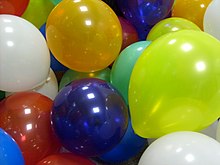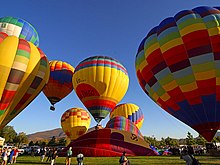Balloon


A balloon is an inflatable flexible bag filled with a type of gas, such as helium, hydrogen, nitrous oxide or air. Modern balloons can be made from materials such as rubber, latex, polychloroprene, or a nylon fabric, while some early balloons were sometimes made of dried animal bladders. Some balloons are purely decorative, while others are used for specific purposes such as meteorology, medical treatment, military defense, or transportation. A balloon's properties, including its low density and relatively low cost, have led to a wide range of applications.
History
In 1643 Evangelista Torricelli, an Italian physicist, showed air was something more than nothing.
The balloon was invented by the Luso Brazilian priest (at 45 years of age) Bartolomeu de Gusmão (brother of the Luso Brazilian statesman Alexandre de Gusmão), and the first public exhibition was to the Portuguese Court on August 8, 1709, in the hall of the Casa da Índia in Lisbon.

Applications
Decoration or entertainment


Party balloons are mostly made of natural latex tapped from rubber trees, and can be filled with air, helium, water, or any other suitable liquid or gas. The rubber's elasticity makes the volume adjustable.
Filling the balloon with air can be done with the mouth, a manual or electric inflator (such as a hand pump), or with a source of compressed gas.
When rubber balloons are filled with helium so that they float, they typically retain their buoyancy for only a day or so. The enclosed helium atoms escape through small pores in the latex which are larger than the helium atoms. Balloons filled with air usually hold their size and shape much longer.
Even a perfect rubber balloon eventually loses gas to the outside. The process by which a substance or solute migrates from a region of high concentration, through a barrier or membrane, to a region of lower concentration is called diffusion. The inside of balloons can be treated with a special gel (for instance, the polymer solution sold under the "Hi Float" brand) which coats the inside of the balloon to reduce the helium leakage, thus increasing float time to a week or longer.

Beginning in the late 1970s, some more expensive (and longer-lasting) foil balloons made of thin, unstretchable, less permeable metalized plastic films started being produced. These balloons have attractive shiny reflective surfaces and are often printed with color pictures and patterns for gifts and parties. The most important attribute of metalized nylon for balloons is its light weight, increasing buoyancy and its ability to keep the helium gas from escaping for several weeks. Foil balloons have been criticized for interfering with landfills and power lines.[1][2]
Professional balloon party decorators use electronic equipment to enable the exact amount of helium to fill the balloon. For non-floating balloons air inflators are used. Professional quality balloons are used, which differ from most retail packet balloons by being larger in size and made from 100% biodegradable latex.
Balloon modeling and balloons in art
Balloon artists are entertainers who twist and tie inflated tubular balloons into sculptures (see balloon modelling). The balloons used for balloon sculpture are made of extra-stretchy rubber so that they can be twisted and tied without bursting. Since the pressure required to inflate a balloon is inversely proportional to the diameter of the balloon[citation needed], these tiny tubular balloons are extremely hard to inflate initially. A pump is usually used to inflate these balloons.
Decorators may use hundreds of helium balloons to create balloon sculptures. Usually the round shape of the balloon restricts these to simple arches or walls, but on occasion more ambitious "sculptures" have been attempted. It is also common to use balloons as tables decorations for celebratory events. Balloons can sometimes be modeled to form different shapes of animals. Table decorations normally appear with 3 or 5 balloons on each bouquet. Ribbon is curled and added with a weight to keep the balloons from floating away.
Balloon drops
A common decorative use for balloons is in balloon drops. In a balloon drop, a plastic bag or net filled with air-inflated balloons is suspended from a fixed height. Once released, the balloons fall onto their target area below. Balloon drops are commonly performed at New Year's Eve celebrations and at political rallies and conventions, but may also be performed at other celebrations, including graduations and weddings.
Balloon publicity
Balloons are often used for publicity at major events. Screen-printing processes can be used to print designs and company logos onto the balloons. In January 2008, the Jewish Community Relations Council of New York organized a display of 4,200 red balloons outside the United Nations building.[3]
Water balloons
Water balloons are thin, small rubber balloons filled with water instead of air or gas, and intended to be easily broken. They are usually used by children, who throw them at each other, trying to get each other wet, as a game, competition, or practical joke. By forcing water out the open end of a water balloon, it is possible to use it as a makeshift water gun.
Balloon rockets
Balloons are often deliberately released, creating so called balloon rocket or rocket balloon. Rocket balloons work because the elastic balloons contract on the air within them, and so when the mouth of the balloon is left open, the gas within the balloon shoots out, and, due to Newton's third law of motion, the balloon is propelled forward. This is fundamentally the same way that a rocket works.[4]
Flying machines

Large balloons filled with hot air or buoyant gas (often hydrogen or helium) have been used as flying machines since the 18th century. The earliest flights were made with hot air balloons using air heated with a flame, or hydrogen; later, helium was used. Unlike airships, balloons' travel is directed exclusively by wind.
Medicine
Angioplasty is a surgical procedure in which very small balloons are inserted into blocked or partially blocked blood vessels near the heart. Once in place, the balloon is inflated to clear or compress arterial plaque, and to stretch the walls of the vessel, thus preventing myocardial infarction. A small stent can be inserted at the angioplasty site to keep the vessel open after the balloon's removal.[5]
Balloon catheters are catheters that have balloons at their tip to keep them from slipping out. For example, the balloon of a Foley catheter is inflated when the catheter is inserted into the urinary bladder and secures its position.[6]
Safety and environmental concerns
There has been some environmental concern over metallized nylon balloons, as they don't biodegrade or shred as rubber balloons do, and a helium balloon released into the atmosphere can travel a long way before finally bursting or deflating. Release of these types of balloons into the atmosphere is considered harmful to the environment. This type of balloon can also conduct electricity on its surface and released foil balloons can become entangled in power lines and cause power outages.[7]
Released balloons can land almost anywhere, including on nature reserves or other areas where they pose a serious hazard to animals through ingestion or entanglement. Latex balloons are especially dangerous to marine life because latex retains its elasticity for 12 months or more when exposed to sea water rather than air.[8] Because of the harm to wildlife and the effect of litter on the environment, some jurisdictions even legislate to control mass balloon releases. Legislation proposed in Maryland, US, was named after Inky, a pygmy Sperm Whale who needed 6 operations after swallowing debris, the largest piece of which was a mylar balloon.[9][10]
See also
- Aerobot
- Balloon-carried light effect
- Foam balloon
- List of balloon uses
- Radiosonde
- Rockoon
- Speech balloon
Notes
- ^ "Metallic balloons spark controversy". Los Angeles Times. April 8, 2008. Retrieved April 15, 2010.]
- ^ "New bill to ban certain balloons". ABC. April 8, 2008.Retrieved April 15, 2010.]
- ^ 4,200 balloons released in NY to protest Qassam fire, By Neta Sela, Ynet News, January 24, 2008.
- ^ Zimmerman Jones, Andrew. "Scientific Explanation: Why the Rocket Balloon Works". How to Create a Rocket Balloon. About:Physics. Retrieved 2007-04-29.
- ^ Berger, Alan (2006-05-30). "Angioplasty". Medical Encyclopedia. MedlinePlus. Retrieved 2007-04-28.
{{cite web}}: Cite has empty unknown parameter:|coauthors=(help) - ^ Bellis, Mary. "History of the Catheter - Balloon Catheter - Thomas Fogarty". About: Inventors. About. Retrieved 2007-04-28.
- ^ Atineh Haroutunian 6/3/2008 (818) 548-3381. "Mylar Balloons Spark Power Outages". Glendalewaterandpower.com. Retrieved 2009-09-15.
{{cite web}}: CS1 maint: numeric names: authors list (link) - ^ Andrady, A.L. (2006-08-06). "Plastics and Their Impacts in the Marine Environment". Proceedings of the International Marine Debris Conference on Derelict Fishing Gear and the Ocean Environment. Hawaii: Hawaiian Islands Humpback Whale National Marine Sanctuary. p. 140.
{{cite conference}}:|access-date=requires|url=(help); Unknown parameter|booktitle=ignored (|book-title=suggested) (help) - ^ "MARP Sponsors Inky Legislation". National Aquarium in Baltimore. Retrieved 2006-12-01.
- ^ "Legislation regulating the release of balloons". Clean Virginia Waterways. Retrieved 2006-12-01.
Further reading
"Reader's Digest: Stories Behind Everyday Things"; New York: Reader's Digest, 1980.
External links
select an article title from: Wikisource:1911 Encyclopædia Britannica
- Stratospheric balloons, history and present Historical recopilation project on the use of stratospheric balloons in the scientific research, the military field and the aerospace activity
- National trade association for the UK balloon industry
- National trade association for the Australasian balloon industry
- Royal Engineers Museum Royal Engineers and Aeronautics
- Royal Engineers Museum Early British Military Ballooning (1863)
